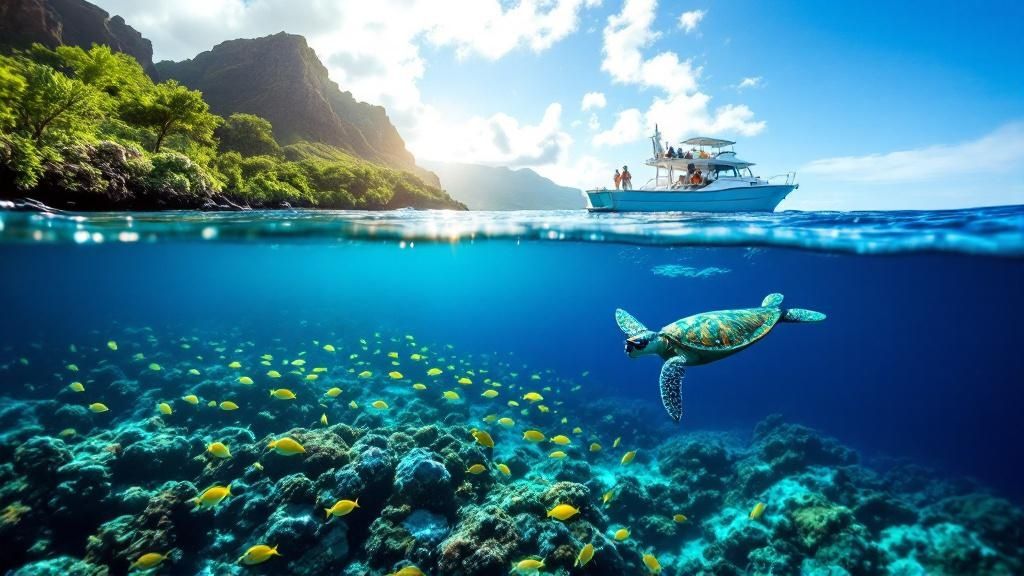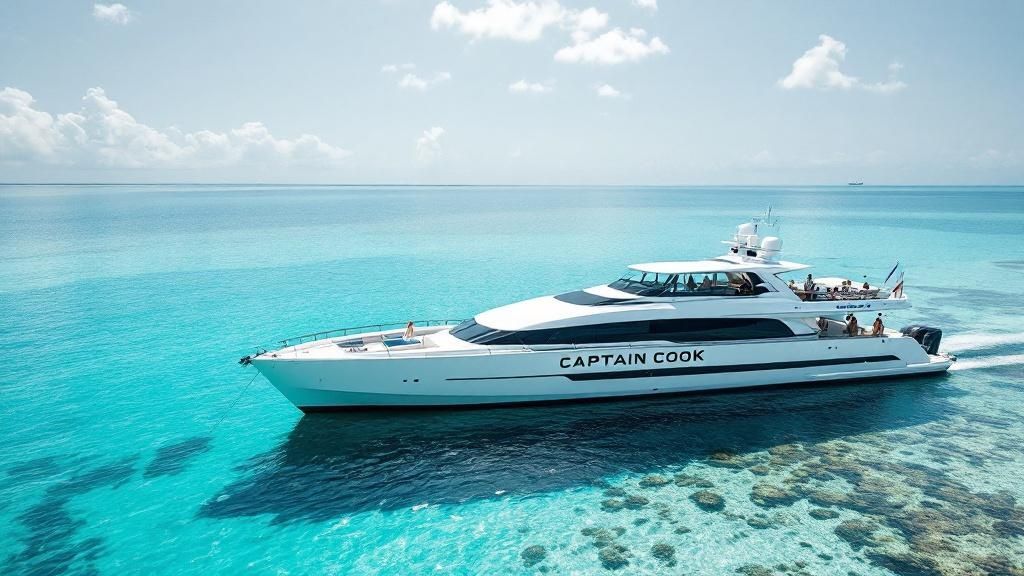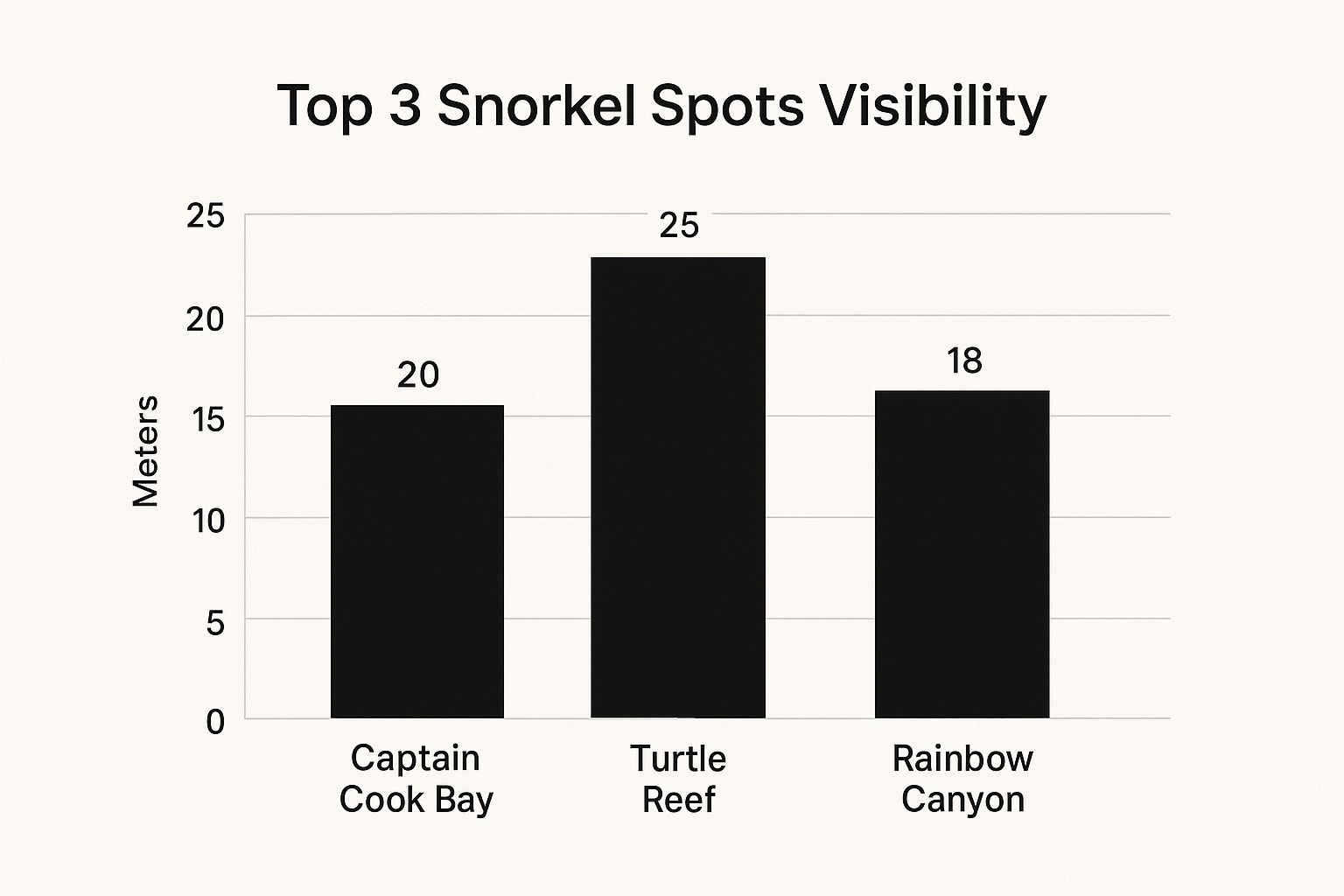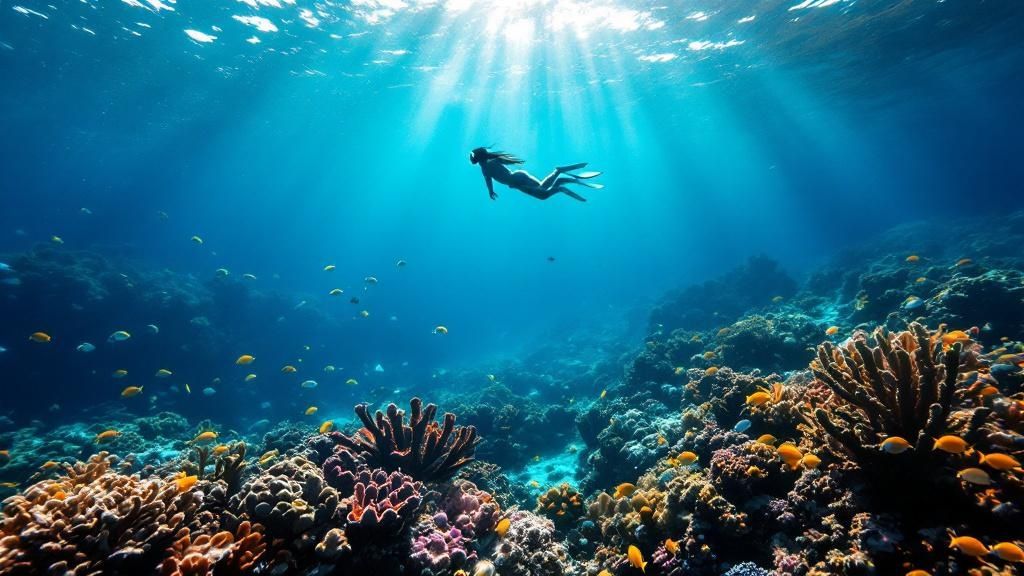Captain Cook Snorkel Tour: The Ultimate Big Island Experience

Why Captain Cook Snorkel Tours Stand Above The Rest
Imagine floating in see-through water as tropical fish swim beneath you, knowing you’re in a spot where history was made. This isn't just another Hawaii snorkel trip; a Captain Cook snorkel tour is where a world-class marine ecosystem meets one of the Pacific's most significant historical moments. This special combination creates an experience that is much more than a simple day on the water, leaving you with a memory that stands out from any other ocean activity in Hawaii. Let's explore what makes Kealakekua Bay so remarkable.

A Unique Blend of History and Nature
The main thing that makes this tour different is its dual identity. On one side, you have a protected Marine Life Conservation District. Picture an underwater national park, where ancient coral reefs thrive and fish populations are plentiful and unafraid of visitors. On the other side, you have a site of deep historical importance. The white obelisk of the Captain Cook Monument marks the place where British explorer Captain James Cook was killed in 1779, a defining event in Hawaiian-Western relations.
This mix of lively nature and rich history is a powerful attraction, drawing over 190,000 visitors to Kealakekua Bay each year. The bay's incredible natural beauty, often with water clarity greater than 100 feet, combined with its compelling cultural story, offers an experience that joins adventure with education. This is a big reason why these tours are so popular and contribute to the local economy. You can explore more about the area's popularity by reviewing the insights on Kealakekua Bay's visitor impact.
What This Means for Your Snorkel Experience
This dual significance brings real benefits to anyone taking a Captain Cook snorkel tour:
- Pristine Conditions: Since the bay is a protected area, the coral is healthier and the marine life is more abundant compared to many other easily accessible snorkel spots.
- Deeper Connection: Knowing the history of the bay adds a layer of meaning to your swim. You're not just observing fish; you're floating through a living story.
- Educational Opportunity: Good tours don't just drop you in the water. Guides often share stories about both the marine ecosystem and the historical events that happened there, making your adventure much richer.
Ultimately, a Captain Cook snorkel tour offers more than just beautiful sights; it provides context. It's a chance to connect with Hawaii's nature and culture on a deeper level, making it a truly memorable part of any visit to the Big Island. For those getting ready for this special adventure, it's also a good idea to check out our guide on how to master your Kona snorkel trip.
Your Captain Cook Snorkel Tour Experience From Start to Finish
Picture this: you're stepping onto the boat, the sun is warm, and a sense of adventure is in the air. You're about to see one of Hawaii's most incredible natural treasures. A Captain Cook snorkel tour isn't just a boat trip; it's a carefully planned experience designed to wow you from the moment you leave the dock. The day kicks off with a beautiful cruise along the Kona coast, setting the perfect mood. As you travel, the guides often share fascinating stories about the volcanic shoreline and the area's rich history, making the journey an adventure in itself.
What a Typical Tour Involves
Once you arrive at the breathtaking Kealakekua Bay, the crew provides a detailed briefing. Think of it as your personal introduction to the underwater world. They'll walk you through everything, from how to get a perfect seal on your snorkel mask to important safety procedures, making sure everyone feels ready and confident. New snorkelers get all the help they need, while seasoned pros might pick up a few expert tips on where to spot elusive marine creatures. This is where a great tour operator really makes a difference—ensuring you're completely comfortable before you even dip a toe in the water.
This infographic shows just how clear the water is at Kealakekua Bay compared to other popular snorkeling destinations.

As you can see, while other reefs have good visibility, your Captain Cook snorkel tour site offers consistently pristine conditions for watching the underwater show.
Group Dynamics and Tour Inclusions
These tours are structured to give you the best and safest experience possible. The main event is, of course, the stunning biodiversity of Kealakekua Bay. Here, sprawling coral reefs are home to a bustling community of colorful tropical fish and graceful sea turtles. The water clarity often exceeds an amazing 100 feet, creating a perfect window into this vibrant world.
To help you choose the right adventure, here's a look at what different tours typically offer.
| Tour Type | Group Size | Duration | Price Range | Included Amenities |
|---|---|---|---|---|
| Large Catamaran | 20-40+ guests | 3-4 hours | $90 – $150 | Basic gear, snacks, historical narration |
| Mid-Size Vessel | 12-20 guests | 4-5 hours | $120 – $180 | Upgraded gear, lunch, drinks, in-water guides |
| Small Group/Private Charter | 6-12 guests | 4-5 hours | $160 – $220+ | Premium gear, custom itinerary, gourmet meals, personalized attention |
As the table shows, there's a tour for every budget and style. Large boats are great for a social atmosphere, while smaller charters offer a more personalized and intimate experience. You can explore the detailed offerings of these diverse tour options to find your perfect match.
After you've had your fill of snorkeling, most tours provide snacks and drinks for the relaxing cruise back to shore. It's the perfect time to kick back, soak in the coastal views, and reflect on the incredible underwater neighborhood you just had the privilege to visit.
Meeting Hawaii's Incredible Marine Life Community
The moment your mask slips beneath the surface on a captain cook snorkel tour, you're not just getting wet—you're being welcomed into a vibrant underwater neighborhood. Kealakekua Bay isn’t simply a body of water; it’s a protected Marine Life Conservation District. This special status acts like a shield, allowing sea creatures to thrive with minimal human disruption. The result is a flourishing ecosystem bursting with life, something rarely seen so close to shore.

The map above shows the protected area of the bay, marking the zone where marine life prospers under conservation laws. This protection is the main reason the underwater world here is so healthy and the fish are so plentiful and calm around snorkelers.
The Stars of the Show: Who You'll Meet
Your underwater journey will feel like meeting the cast of a hit show. Think of the reef as a massive, multi-level apartment complex, where every resident plays a part in the community.
- Schools of Yellow Tang (lauʻipala): These bright yellow fish move together like a flowing river of sunshine, sometimes in groups of hundreds. They are the bay's dedicated gardeners, constantly grazing on algae to keep the coral reefs clean and healthy. Seeing a huge school of them is a true highlight of any captain cook snorkel tour.
- Hawaiian Green Sea Turtles (honu): Spotting these ancient, graceful giants is a common and truly moving experience. You might see them gliding effortlessly over the reef or resting quietly on the sandy bottom. Watching a honu in its natural home is a powerful reminder of why this bay is such an important sanctuary.
- Spinner Dolphins (naiʻa): While not guaranteed, pods of spinner dolphins often cruise into the bay to rest and play. Their amazing acrobatic jumps are an unforgettable bonus to an already spectacular day on the water.
Understanding the Underwater Neighborhood
The health of this entire community relies on the complex connections between its inhabitants. The coral formations, some of which are hundreds of years old, provide the foundation for the whole ecosystem. They are the high-rise buildings, offering food and shelter to countless smaller creatures, from dazzling reef fish to well-hidden octopuses (heʻe).
Here’s a quick guide to some of the residents you’re most likely to see.
| Marine Resident | Likelihood of Sighting | Behavior to Watch For |
|---|---|---|
| Yellow Tang | Very High | Grazing on coral in large, vibrant schools |
| Green Sea Turtle | High | Gliding slowly or resting on the sandy floor |
| Parrotfish (uhu) | High | Scraping algae off coral with their beak-like mouths |
| Moorish Idol | Medium | Moving gracefully in pairs with long, trailing dorsal fins |
| Spinner Dolphins | Medium | Traveling in pods, often seen during the boat ride |
Learning to recognize these key species turns your snorkeling trip from simple sightseeing into a real exploration. You start to see the bay not just as a beautiful scene, but as a living, breathing system. For those curious about the island's other aquatic wonders, you might find our guide to other Big Island snorkeling tours helpful.
The Captain Cook Story: History Beneath The Waves
That striking white monument you see from the water is much more than a scenic landmark; it's a marker for a complex and pivotal moment in Pacific history. When you're floating in the calm waters of Kealakekua Bay on a captain cook snorkel tour, you are at the exact location of British explorer Captain James Cook's final, fateful encounter in 1779.
Understanding this history adds a powerful layer to your experience. It turns a beautiful swim into a visit to a living museum, where a significant story lies just beneath the surface of the waves.
A Tale of Two Worlds Colliding
The story of Cook’s death is a dramatic example of cultural misinterpretation. When Captain Cook's ships first arrived, his timing lined up perfectly with the Makahiki festival, a sacred Hawaiian period dedicated to honoring the god Lono. The Hawaiians welcomed him warmly, with some believing he was a physical manifestation of Lono himself. This initial perception led to a time of peaceful exchange.
Unfortunately, this harmony didn't last. After the festival had concluded, Cook's ships had to return unexpectedly for repairs. The cultural setting had changed completely. Tensions rose quickly over a stolen boat, sparking a confrontation that tragically ended with Cook's death right on the shoreline. This event became a major turning point in the relationship between Hawaiians and the Western world.
The Monument and Its Meaning Today
The Captain Cook Monument, a 27-foot-tall white obelisk, was put up by Great Britain in 1874. In an interesting historical footnote, the small piece of land it occupies was deeded to the United Kingdom and is technically British soil. This site is only reachable by boat or a very demanding hike.
For some, the monument is a tribute to a world-renowned explorer. For many Native Hawaiians, however, it symbolizes a more complicated legacy of colonialism and cultural loss. Quality tour operators recognize this dual perspective. They share the history with respect, honoring Cook's incredible achievements in navigation while also giving voice to the rich Hawaiian side of the story. This balanced approach ensures your captain cook snorkel tour is not just an adventure but also a meaningful cultural education, deepening your appreciation for this sacred place.
Finding Your Perfect Captain Cook Snorkel Tour Match
Choosing the right Captain Cook snorkel tour from the many available options can feel like a big decision, but it becomes much clearer once you know what to look for. Think of it like picking a guide for a mountain hike; you want someone whose style and pace match your own experience level and what you hope to get out of the day. The trick is to look past just the price tag and focus on the kind of experience you want to have in Kealakekua Bay.

To help you sift through the options, we've put together a guide that breaks down the key factors for different types of snorkelers.
| Factor | Beginner Priority | Experienced Priority | Family Priority | What to Look For |
|---|---|---|---|---|
| Boat Size | Small Group: More guide attention and less crowding. | Either: Depends on social vs. intimate preference. | Large Boat: More amenities like slides and space. | Check the maximum guest count. Look for 12-16 for small groups or 20-40+ for larger vessels. |
| Guide Expertise | Safety & Instruction: Lifeguard-certified guides are crucial. | Marine Biology & History: Guides who can point out specific species or share local lore. | Engaging & Patient: Guides who are good with kids and can make learning fun. | Read tour descriptions for mentions of "lifeguard-certified," "marine biologist," or "historical narration." |
| Tour Focus | Instructional: A tour that prioritizes getting comfortable in the water. | Exploration: High-speed rafts or tours that visit multiple spots or sea caves. | All-Inclusive Fun: Tours with food, drinks, and extra activities included. | Look for keywords like "beginner-friendly," "adventure," "sea caves," or "family fun package." |
| Amenities | Quality Gear: Well-maintained masks, snorkels, and fins. | Freedom & Time: Less structured tours that allow for more independent snorkeling. | Convenience: Onboard restrooms, shade, and easy water access. | Check the tour's list of included amenities. See if they offer prescription masks or flotation devices. |
This table shows that the "best" tour is entirely subjective. A family with young kids will value different features than a seasoned free-diver looking for a new adventure.
Small Group Intimacy vs. Big Boat Energy
One of the most significant decisions you'll make is the size of the boat and your tour group. Larger catamarans, which often carry 20-40+ passengers, create a lively, social atmosphere. They usually come packed with amenities like water slides, spacious sun decks, and onboard restrooms, providing a stable and comfortable ride that's ideal for families seeking an all-in-one adventure package.
On the other hand, smaller boats, like those operated by Kona Snorkel Trips with a maximum of just 12-16 guests, deliver a much different vibe. With fewer people on board, you get far more personalized attention from the lifeguard-certified guides. This is a massive benefit for first-time snorkelers who might appreciate extra tips or for anyone with questions about the fascinating marine life. These smaller groups tend to foster a quieter, more respectful atmosphere when observing the incredible wildlife.
Matching the Tour Focus to Your Interests
Not all snorkel tours are built the same; each one has its own special character. Some tour operators make the historical narrative a centerpiece, turning the boat ride into a captivating story about Captain Cook's arrival and ultimate fate. Others are led by passionate marine biology experts who offer amazing insights into the reef's complex ecosystem. You'll also find tours geared toward pure adventure, using high-speed rafts to explore hidden sea caves along the coast.
Think about what matters most to you for this trip. Are you hoping to identify the fish you see, or do you simply want to spend as much time as possible exploring the underwater world? Asking an operator about their guides' backgrounds is an excellent way to see if their tour is the right fit. For more ideas, you can read our guide on Captain Cook snorkeling to learn what sets a quality tour apart. The perfect Captain Cook snorkel tour is the one that aligns with your personal style, guaranteeing a comfortable and unforgettable day on the water.
Staying Safe And Comfortable In Paradise
Your safety and comfort are the top priorities for any good operator on a captain cook snorkel tour. While Kealakekua Bay's waters are known for being calm and welcoming, being prepared can elevate your day from good to unforgettable. Think of your tour crew like airline pilots running through a pre-flight checklist; they follow strict safety procedures to make sure everyone has a smooth and secure adventure, no matter their swimming skill or ocean experience.
Overcoming Common Concerns
For many people, especially those new to snorkeling, the vastness of the open ocean can feel a little daunting. That's a completely normal feeling, and the best tours are set up to help build your confidence from the moment you climb aboard the boat.
- Nervous or Non-Strong Swimmers: Modern snorkel gear is a real game-changer. High-quality, soft silicone masks provide a comfortable and leak-free fit, while dry-top snorkels feature a special valve that keeps water out of the breathing tube. On top of that, buoyancy aids like foam noodles or inflatable vests are always available. These aren't just for children; they allow you to float effortlessly, saving your energy so you can focus entirely on the incredible marine world below.
- Seasickness: The boat trip to the bay is a scenic part of the experience, but if you know you're prone to motion sickness, a little preparation goes a long way. You might consider taking an over-the-counter remedy like Dramamine or Bonine the night before and again on the morning of your tour. Staying hydrated and focusing your gaze on the steady horizon can also make a huge difference.
What to Bring vs. What's Provided
Packing the right items ensures you're comfortable during every part of your tour. While the operator handles all the main equipment, a few personal things are key for a perfect day on the water.
| Provided by Quality Operators | What You Should Bring |
|---|---|
| Snorkel, mask, and fins | Reef-safe sunscreen (non-nano zinc oxide) |
| Flotation devices (noodles, vests) | Towel and a change of clothes |
| In-water assistance from guides | Hat and polarized sunglasses |
| Snacks and hydration | Reusable water bottle |
| Prescription masks (often available) | Waterproof camera or phone case |
Reputable companies like Kona Snorkel Trips go the extra mile by ensuring all their guides are lifeguard-certified, which adds another layer of security to your trip. Their small tour sizes also guarantee you receive personalized attention, so never hesitate to ask for assistance. With the right gear, a professional crew, and a little planning, you can relax and completely immerse yourself in the underwater wonders of your captain cook snorkel tour.
Protecting Paradise For Future Generations
Kealakekua Bay's incredible underwater world isn't beautiful by chance; its health is a direct result of focused conservation efforts and the respectful actions of every visitor. When you join a captain cook snorkel tour, you become a temporary guardian of this amazing ecosystem. It helps to think of the reef as a living, breathing city—it’s built to host visitors, but it only truly thrives when those visitors are gentle and mindful.
The Real Challenges Facing Hawaii's Reefs
Like coral reefs around the globe, this sanctuary is up against some serious pressures. Increasing ocean temperatures can trigger coral bleaching, a stress reaction where coral expels the colorful algae living inside its tissues, causing it to turn stark white. On top of that, the bay's popularity brings thousands of visitors each year, and that collective footprint can have a major impact if not managed well. Every choice you make, from the sunscreen you apply to how you swim, truly matters.
One of the biggest direct threats is sunscreen pollution. Many popular sunscreens contain chemicals like oxybenzone and octinoxate, which are known to be extremely harmful to coral polyps, even in very small amounts. This is precisely why Hawaii has banned sunscreens that contain these specific chemicals.
Your Role as a Reef Guardian
Protecting this paradise is a team effort, and your part is easier than you might imagine. By following a few simple guidelines, you can actively contribute to the bay's preservation for years to come.
- Wear Reef-Safe Sunscreen: This is a must-do for any responsible captain cook snorkel tour. Always pick a mineral-based sunscreen that lists non-nano zinc oxide or titanium dioxide as its active ingredients. These create a physical block on top of your skin instead of a chemical one that washes off into the water.
- Keep Your Distance: The golden rule of interacting with wildlife is to look but don't touch. Never chase, corner, or touch any marine life. This rule absolutely includes the coral itself. It’s a colony of living animals, and a single touch from a hand or a fin can damage or even kill it.
- Leave No Trace: Make sure everything that comes with you also leaves with you. This straightforward action prevents dangerous plastics and other trash from polluting the water and harming the creatures that call it home.
When you book a tour with a trusted operator like Kona Snorkel Trips, you are also supporting a business that puts environmental care at the heart of its operations. Their guides not only prioritize your safety but also teach guests about these vital conservation practices, ensuring this natural wonder remains for future generations to explore.
